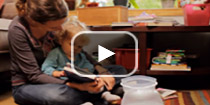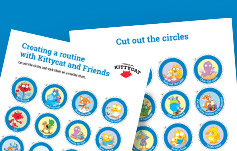From meals to baths to bedtime, children need routines!
Routines lend structure to a child’s day, as actions and events occur in the same sequence and at around the same time each day. The more predictable your child’s day is, the more secure they’ll feel.
Why are routines important?
Routines help ensure that some of your child’s basic needs (sleep, hygiene, food, etc.) are met. But they also go beyond physical care. They help your child feel secure and teach them to take care of their body and be more responsible.
Routines can also simplify your day and help maintain harmony at home or at daycare. With a clear, well-established routine, your child knows what’s expected of them. This helps you avoid negotiating. You won’t have to repeat yourself as much, and you’ll be less inclined to lose your patience or yell.
Children are more likely to cooperate when they know their routine. Plus, routines can help your child develop a healthy sense of self-esteem.
Feeling secure
Clearly established routines are reassuring for a child because they let them know what to expect and give them a sense of time. For example, when your child knows the steps of their bedtime routine, they feel secure. This helps them fall asleep more easily, since they need to be fully relaxed and calm to doze off.
During the routine, describe the steps and their purpose out loud. For example, you could say, “It feels better to have a full stomach!” or “It’s nice to have clean hands—they smell good!”
Developing autonomy
Through routines, a child gradually learns to take care of themself: how to go to the bathroom on their own, wash their hands, brush their teeth, get dressed, and so on. For example, with a morning routine, your child learns that they start their day by getting dressed, which is followed by eating breakfast and then brushing their teeth.
Knowing what to do and in what order gives them a sense of control. They begin to feel more autonomous, self-confident, and capable. They also feel a sense of pride.
Discover why routines are a good way to teach your child to self-regulate and control their behaviour.

You also help your child develop autonomy when you allow them to make choices during routines. For example, you can suggest two sweaters and let your child pick which one to wear. Giving your little one options, however limited they may be, can encourage them to take a more active role in everyday decisions. Depending on their age, they might even be able to put their sweater on by themself. If your child is very young, let them try first, and only help if needed.
Letting your child get dressed at least partway on their own will help them improve their coordination skills. It will also make them feel proud to be able to do things with less and less help.
Developing social skills and a sense of responsibility
Routines teach your child to be disciplined and persevere. This is true, for example, when entrusting your child with age-appropriate household tasks or establishing an after-school homework routine. This helps them develop good work habits.
At daycare, routines help your child acquire social skills. For example, they gradually learn to wait their turn to use the sink.
It’s never too late to introduce routinesIf you haven’t really established any routines with your child yet, it’s not too late. Your child may be a little stubborn at first, especially if they’re used to deciding what to do, but being patient will eventually pay off. Their bedtime routine is a good place to start, since the sequence of steps is easy for your child to understand: they put on their pyjamas after bath time, read a story with you, etc. |
The secrets of a good routine
Find the best times of day to implement a routine. The most important routines include their morning routine (what they do to start their day) and their evening routine (what they do before bedtime). But it can also be useful to create routines around other daily activities, such as meals or tidying up after playtime or homework time.
Here are some tips for developing effective routines:
- Try to stay calm, confident, and cheerful as your child learns a new routine.
- Be consistent. Routines should be done the same way and at the same time every day. You and your child’s other parent should be on the same page when it comes to your child’s routines.
- Keep it simple. A routine shouldn’t have too many steps. Otherwise, your child will have a hard time remembering it. Keep your expectations realistic for their age so that they feel competent.
- Make sure the routine is clear and that your child understands it. Visual aids such as a chart, pictogram, or checklist can help them remember the steps. You may need to remind them to look at it.
- Involve your child. If your child feels like they have some say in their routine, they’ll be more willing to cooperate. For example, you can ask if they’d like to read their bedtime story before or after their bath. Make their visual aids together if you can.
Help your child develop good routines from morning to night. Download this Kittycat and friends routine builder!

- Be flexible. As your child gets older, you should adapt their routines to suit their age and ability. For example, if they’re now able to put their coat on by themself, consider adding this small task to their morning routine before daycare or school. You may sometimes need to do your child’s routine differently or later than usual, for example when you have guests. Let your child know that you’re doing things a little differently today, and help them adjust as needed.
- Set a good example. Show your child that you have routines too! For example, when it’s time to clean up, you can tidy up the kitchen while your child puts their toys away.
- Choose the right time for the routine. For example, your child’s homework routine should start at a time that makes sense for their schedule, energy levels, and ability to focus.
- Remind your child how much time they have left as needed. An hourglass or Time Timer visual timer can help your child visualize how much time they have to finish their routine and manage their time more wisely.
- Make routines fun. For example, you could make a poster with funny pictures for each step of your child’s routine. Or, you could sing the same song with your child whenever it’s time to clean up or wash their hands. Incorporating humour and games can also be handy. For example, you could say “How fast do you think you can put all your toys away?” and challenge them to race the timer.
- If your child resists the routine, try to understand why. Listen to them and help them get started. If they struggle, stay nearby, but wait a little bit before you step in to help or do the task for them. Let them try it on their own, offer encouragement, and give only as much help as needed. Praise them when they succeed.
Home and daycare: Separate routinesChildren generally don’t have any trouble following one routine at home and another at daycare. They adapt to what’s expected in each environment and understand the differences when you explain them. However, some kids may get upset at certain times of day, such as before naps or meals. If this is the case for your child, talk to their educator about what you can do to make their home and daycare routines more similar. The fewer differences there are, the less anxious your child will feel. |
The benefits of school routines
Routines help children learn organizational skills and develop habits they can apply at school, such as getting dressed on their own before going outside, washing their hands after going to the bathroom, or putting their toys away after playtime.
If your child already has a routine at home, they will have an easier time following instructions at school and get along better with others. Children who have gained a sense of trust and security through familiar home routines are also more receptive to learning.
Things to keep in mind
-
Routines make your child feel secure and confident.
-
If your child has routines at home, they’ll have an easier time following instructions at daycare or at school.
-
It’s never too late to establish routines with your child.
Photo: iStock.com/DMP
Sources and references
Note: The links to other websites are not updated regularly, and some URLs may have changed since publication. If a link is no longer valid, please use search engines to find the relevant information.
-
Asselin, Viviane. “The benefits of a homework routine.” Alloprof.alloprof.qc.ca/en/
-
Bilodeau, Mélanie. Être un parent sécurisant : le sommeil du tout-petit. Quebec City, Éditions Midi trente, 2024, 120 pp.
-
CHU Sainte-Justine. “Health promotion.” Promotion de la santé CHU Sainte-Justine. www.promotionsante.chusj.org
-
Doyon, Nancy. SOS dodo : 10 raisons pour lesquelles les enfants refusent d’aller au lit… Quebec City, Éditions Midi trente, 2015, 96 pp.
-
Faber, Joanna, and Julie King. How to Talk So Little Kids Will Listen. Illustrated edition, New York City, Scribner, 2017, 432 pp.
-
Ferland, Francine. Viens jouer dehors! Pour le plaisir et la santé. Montreal, Éditions du CHU Sainte-Justine, 2012, 122 pp.
-
Martello, Evelyne. Enfin je dors… et mes parents aussi. 2nd ed., Montreal, Éditions du CHU Sainte-Justine, 2015, 150 pp.
-
Racine, Brigitte. L’autorité au quotidien : un défi pour les parents. Montreal, Éditions du CHU Sainte-Justine, 2018, 288 pp.
Books for kids -
Chincholle, Camille. Au dodo, petit coquin! Paris, Éditions Gallimard jeunesse, 2017, 12 pp.
-
Côté, Geneviève. Bonne nuit, toi! Markham, Scholastic, 2014, 32 pp.
-
John, Jory, and Benji Davies. Goodnight Already! Markham, Scholastic, 2015, 32 pp.
-
Lallemand, Orianne, and Eléonore Thuillier. Bonne nuit, P’tit Loup! Paris, Éditions Auzou, 2014, 32 pp.
-
Primeau, Diane, and Julie Cossette. Au lit, Dafné ! Longeuil, Ma bulle éditeur, 2014, 28 pp.
-
Roberge, Sylvie, and Yves Dumont. Au lit, Petit Gribouillis! Saint-Lambert, Dominique et compagnie, 2012, 16 pp.
|